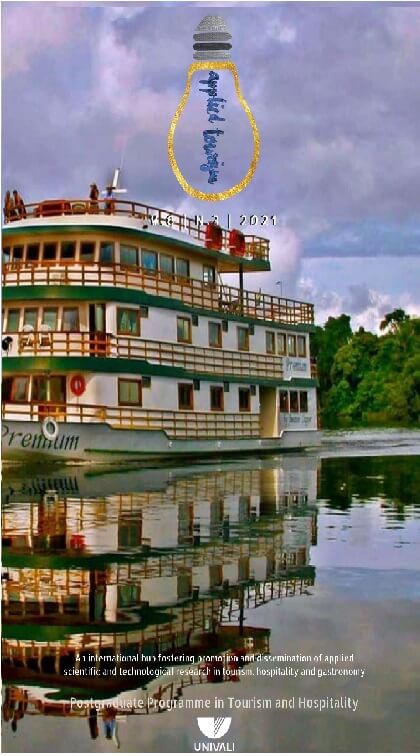FROM BENEDITO'S RED TO SEBASTIÃO'S BLUE: making festival and attractiveness of Marujada in the Brazilian Amazon
DOI:
https://doi.org/10.14210/at.v6n3.p55-66Keywords:
Party, Touristic Attraction, TourismAbstract
The attractiveness from events based on sociocultural valorization foments the tourist destination. Thus, this work seeks to analyze the act of making festivals and the attractiveness of Marujada in the Brazilian Amazon in Tracuateua city. The analysis procedures involved the research in a qualitative way, through the survey of documentary and bibliographic data, with fieldwork including semi-structured interviews and field notes with guided observation script and semi-structured interview conducted with 12 organizers and makers of Tracuateua’sMarujada festival. The results demonstrate that the act of making festivals allows the fraternization of frequenters, through the act of partying, and the attractiveness provided by Marujada can attract tourist flows. In addition to encouraging the culture of the microregion of Bragança and strengthening the festival. It is considered that the Marujada party contributes positively to the safeguard of local culture.
References
Amaral, R. (1998). Festa à brasileira: significados do festejar, no país que “não é série”. Tese
(Doutorado em Antropologia) pela Universidade de São Paulo. Bahl, M. (2004). Viagens e roteiros turísticos. Curitiba-PR: Protexto.
Berselli, C., & Zucco, F. D. (2019). A imagem da Festa Nacional do Doce – Fenadoce em Pelotas
(RS), Brasil, perante a percepção dos residentes. Applied Tourism, 4 (1), 41-56.
Bueno, M. (2008). Lazer, festa e festejar. Revista de Cultura e Turismo (CULTUR), 2 (2), 1-18. Caillois, R. (1988). O homem e o sagrado. Lisboa: Edições 70.
Carvalho, G. (2010). A festa do “Santo Preto”: tradição e percepção da Marujada Bragantina.
Dissertação (Mestrado Desenvolvimento Sustentável) pela Universidade de Brasília.
Claval, P. (2011). A festa e a cidade. Revista Cidades, Grupos de Estudos Urbanos, Presidente
Prudente, 8 (13), 27-44.
Da Matta, R. (1997). Carnavais, malandros e heróis: para uma sociologia do dilema brasileiro.
ed. Rio de Janeiro: Rocco.
Deslandes, S. (1994). A Construção do projeto de Pesquisa. Pesquisa Social: teoria, método e criatividade. 31-49. Petrópolis, RJ: Vozes, 1994.
Espeso-Molinero, P. (2019). Tendencias del turismo cultural. Revista de Turismo y Patrimônio
Cultural, 17 (6), 1101-1112.
Ferretti, S. (2007). Religião e Culturas Populares. In: XIV Jornadas sobre Alternativas Religiosas en América Latina. Acesso em 15 jan. 2020. Disponível em www.gpmina.ufma.br/pastas/doc/Religião/FestasPopulares.Pdf.
Filippim, M. L.; Bahl, M. (2017). Experiências de ressignificação de tradições carnavalescas em
Podence e ovar, Portugal. Caderno Virtual de Turismo. 17 (1), 155-170.
Gomes, R. (1994). A análise de dados em pesquisa qualitativa. In: Minayo, M. C. Pesquisa
Social: teoria, método e criatividade. 67-79. Petrópolis, RJ: Vozes.
Minayo, M. C. (2002). Pesquisa Social: teoria, método e criatividade. Petrópolis, RJ: Vozes. Pará. Secretaria de Estado de Turismo do Pará. (2011). Plano Ver o Pará: plano estratégico de
turismo do estado do Pará. Belém. Acesso em 16 de jan. de 2020. Disponível em http://www.setur.pa.gov.br/plano-ver-o-para.
Pará. Secretaria de Estado de Turismo do Pará. (2013). Pesquisa de Demanda Turística do
Festival da Marujada, Bragança-PA. Acesso em 10 fev. 2020. Disponível em http://setur.pa.gov.br/sites/default/files/pdf/pesquisa_de_demanda_turistica_do_fest ival_ da_marujada_2013.pdf
Pará. Secretaria de Estado de Turismo do Pará. (2014). Inventário da Oferta Turística de Tracuateua. Acesso em 10 fev. 2020. Disponível em http://www.setur.pa.gov.br/si- tes/default/files/pdf/inventario_tracuateua_-_2013final.pdf
Pinheiro, A. J. (2017). Síntese histórica de Tracuateua. Belém: Ed. do Autor.
Raffestin, C. A. (2009). Produção das estruturas territoriais e sua representação. In: Saquet, M., & Sposito, E. (Org.). Territórios e territorialidades: teorias, processos e conflitos. São Paulo: Expressão Popular.
Santos, M. (1999). A natureza do espaço: espaço e técnica, razão e emoção. São Paulo: Hucitec.
Cruz Neto, O. (1994). O trabalho de campo como descoberta e criação. Pesquisa Social: teoria, método e criatividade. 51-66. Petrópolis, RJ: Vozes.
Soja, E. W. (1993). Geografias pós-modernas a reafirmação do espaço na teoria social crítica.
Tradução de Vera Ribeiro. Rio de Janeiro: Zahar.
Sollerio, A. A. A., & García, O. M. (2020). La producción del espacio social en Playa del Carmen,Quintana Roo, México. Espacialidad, Socialidad e Historicidade RBTUR, São Paulo, 14 (2), 95-122.
Wagner, R. (1981). The Invention of Culture. Chicago: The University of Chicago Press.
Downloads
Published
Issue
Section
License
In this term of responsibility I (we) certify the participation in the drafting of the attached article, thereby making public my (our) responsibility for its content. I (we) declare not omitting any connections or financing agreements between I (we) and entities and / or institutions that may have an interest in the publication of this article. I (we) certify that the article is original and that the work, in whole or in part, or any other work with content substantially similar to my (our) authorship, in any other format (printed or electronic), was not sent to another journal and will not be sent while is being considered by the Applied Tourism. In this consent form, the authors give permission to the journal, in the case of approval by the Editorial Board, for the publication of the attached article in hard copy and/or electronic form, in a regular edition of the journal.










